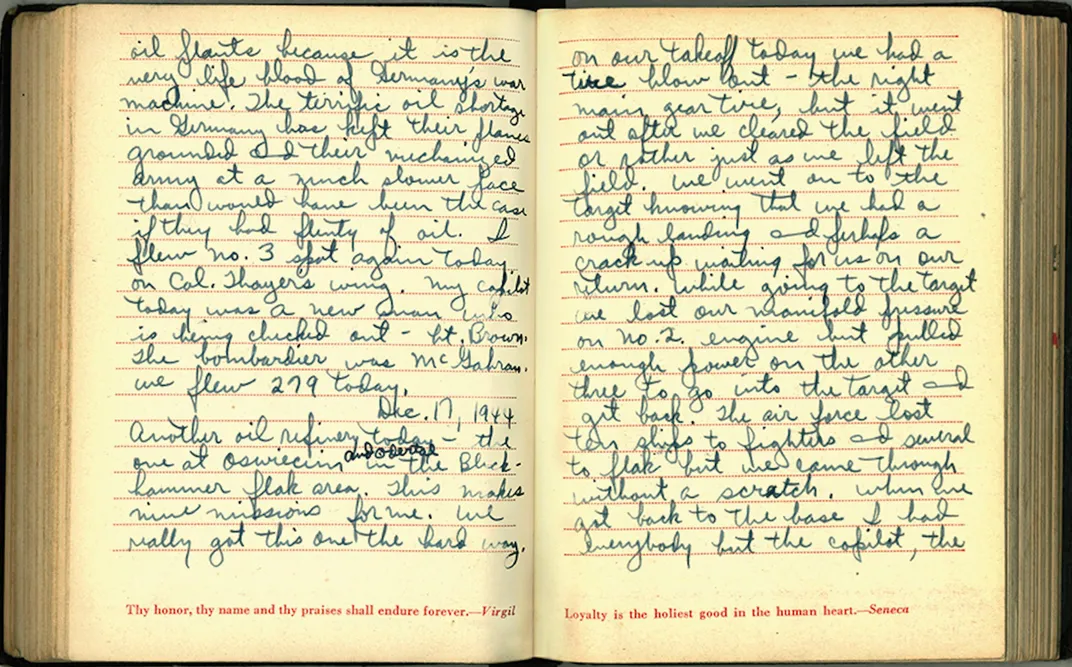George McGovern’s WWII Diary
Notes from the one-time presidential nominee’s 35 combat missions.
/https://tf-cmsv2-smithsonianmag-media.s3.amazonaws.com/filer/62/e8/62e85699-83fa-47b5-a86c-d01cb86ae466/mcgovern_cover.jpg)
From 1943 until World War II’s end, the men of the 455th Bombardment Group climbed into their big B-24 Liberators each day and headed toward their targets. They flew over Germany, Italy, Poland, and France, dropping bombs on oil refineries, railroads, and airfields. Over the course of 252 combat missions they would lose 118 aircraft.
One of those B-24 pilots was future senator and presidential nominee George McGovern. Based in Italy, McGovern flew 35 combat missions between 1944 and 1945, earning the Distinguished Flying Cross for his efforts. My Life in the Service presents, in facsimile form, McGovern’s wartime experiences from basic training through his final mission. Recruits were encouraged to keep journals, and were even given blank diaries. For those not comfortable with writing, the diary suggested topics like: “My Buddies in the Service: What I liked and disliked about him,” “Officers I Have Met,” and “Places I Have Been.” And there is also space, of course, for daily entries. (The book is published by Franklin Square Press, a division of Harper’s Magazine; McGovern was a board member on the magazine from 1990 until his death.)

The entry from December 17, 1944, reads:
Another oil refinery today—the one at Oswiecim and Odertal in the Blechhammer flak area. This makes nine missions for me. We really got this one the hard way. On our takeoff today we had a tire blow out—the right main gear tire, but it went out after we cleared the field or rather just as we left the field. We went on to the target knowing that we had a rough landing and perhaps a crack up waiting for us on our return. While going to the target we lost our manifold pressure on no. 2 engine but pulled enough power on the other three to go into the target and get back. The air force lost ten ships to fighters and several to flak but we came through without a scratch. When we got back to base I had everybody but the copilot, the engineer, and myself go back to the waist and brace themselves for the landing. We made sure that all the loose objects were tied down securely. As soon as we touched the runway I chopped the throttle on the side of the good wheel and advanced the throttle on the side of the blown tire at the same time holding down the left brake. We made the landing O.K. without damaging the plane in the least. Needless to say old terra firma felt plenty good. My copilot today was Lt. Brown and the bombardier was Lt. McGrahan. These two boys and Sam recommended me for the D.F.C. because of the landing but I don’t feel as though I deserve a medal as yet.
World War II ended shortly after McGovern’s 35th combat mission, to bomb the Linz central railway station in Austria. “We had well over 75 holes in our plane,” he wrote in his diary on April 25, 1945. “In a way this was a good one to quit on because it made me more thankful than ever that I had finished.”
McGovern returned to South Dakota, where he taught history and political science before entering politics in 1955. After a stint as a congressman and a senator, McGovern would become the Democratic nominee for president in 1972. He later became president of the Middle East Policy Council in the 1990s, and the first United Nations global ambassador on hunger, in 2001. McGovern died in 2012, at age 90.